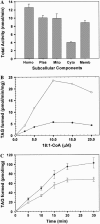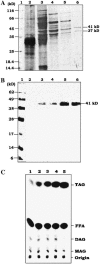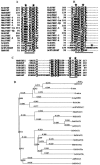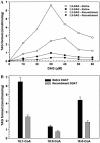Cytosolic triacylglycerol biosynthetic pathway in oilseeds. Molecular cloning and expression of peanut cytosolic diacylglycerol acyltransferase
- PMID: 16798944
- PMCID: PMC1533943
- DOI: 10.1104/pp.106.082198
Cytosolic triacylglycerol biosynthetic pathway in oilseeds. Molecular cloning and expression of peanut cytosolic diacylglycerol acyltransferase
Abstract
Triacylglycerols (TAGs) are the most important storage form of energy for eukaryotic cells. TAG biosynthetic activity was identified in the cytosolic fraction of developing peanut (Arachis hypogaea) cotyledons. This activity was NaF insensitive and acyl-coenzyme A (CoA) dependent. Acyl-CoA:diacylglycerol acyltransferase (DGAT) catalyzes the final step in TAG biosynthesis that acylates diacylglycerol to TAG. Soluble DGAT was identified from immature peanuts and purified by conventional column chromatographic procedures. The enzyme has a molecular mass of 41 +/- 1.0 kD. Based on the partial peptide sequence, a degenerate probe was used to obtain the full-length cDNA. The isolated gene shared less than 10% identity with the previously identified DGAT1 and 2 families, but has 13% identity with the bacterial bifunctional wax ester/DGAT. To differentiate the unrelated families, we designate the peanut gene as AhDGAT. Expression of peanut cDNA in Escherichia coli resulted in the formation of labeled TAG and wax ester from [14C]acetate. The recombinant E. coli showed high levels of DGAT activity but no wax ester synthase activity. TAGs were localized in transformed cells with Nile blue A and oil red O staining. The recombinant and native DGAT was specific for 1,2-diacylglycerol and did not utilize hexadecanol, glycerol-3-phosphate, monoacylglycerol, lysophosphatidic acid, and lysophosphatidylcholine. Oleoyl-CoA was the preferred acyl donor as compared to palmitoyl- and stearoyl-CoAs. These data suggest that the cytosol is one of the sites for TAG biosynthesis in oilseeds. The identified pathway may present opportunities of bioengineering oil-yielding plants for increased oil production.
Figures








Similar articles
-
Cloning and molecular characterization of a novel acyl-CoA:diacylglycerol acyltransferase 1-like gene (PtDGAT1) from the diatom Phaeodactylum tricornutum.FEBS J. 2011 Oct;278(19):3651-66. doi: 10.1111/j.1742-4658.2011.08284.x. Epub 2011 Sep 6. FEBS J. 2011. PMID: 21812932
-
Identification and functional expression of a type 2 acyl-CoA:diacylglycerol acyltransferase (DGAT2) in developing castor bean seeds which has high homology to the major triglyceride biosynthetic enzyme of fungi and animals.Phytochemistry. 2006 Dec;67(23):2541-9. doi: 10.1016/j.phytochem.2006.09.020. Epub 2006 Nov 7. Phytochemistry. 2006. PMID: 17084870
-
The wax ester synthase/acyl coenzyme A:diacylglycerol acyltransferase from Acinetobacter sp. strain ADP1: characterization of a novel type of acyltransferase.J Bacteriol. 2005 Feb;187(4):1369-76. doi: 10.1128/JB.187.4.1369-1376.2005. J Bacteriol. 2005. PMID: 15687201 Free PMC article.
-
Key enzymes for biosynthesis of neutral lipid storage compounds in prokaryotes: properties, function and occurrence of wax ester synthases/acyl-CoA: diacylglycerol acyltransferases.Biochimie. 2007 Feb;89(2):230-42. doi: 10.1016/j.biochi.2006.07.013. Epub 2006 Aug 7. Biochimie. 2007. PMID: 16938377 Review.
-
Acyl-CoA:diacylglycerol acyltransferase: molecular biology, biochemistry and biotechnology.Prog Lipid Res. 2012 Oct;51(4):350-77. doi: 10.1016/j.plipres.2012.06.001. Epub 2012 Jun 15. Prog Lipid Res. 2012. PMID: 22705711 Review.
Cited by
-
Functional Characterization of the Effects of CsDGAT1 and CsDGAT2 on Fatty Acid Composition in Camelina sativa.Int J Mol Sci. 2024 Jun 25;25(13):6944. doi: 10.3390/ijms25136944. Int J Mol Sci. 2024. PMID: 39000052 Free PMC article.
-
A thraustochytrid diacylglycerol acyltransferase 2 with broad substrate specificity strongly increases oleic acid content in engineered Arabidopsis thaliana seeds.J Exp Bot. 2013 Aug;64(11):3189-200. doi: 10.1093/jxb/ert156. Epub 2013 Jun 28. J Exp Bot. 2013. PMID: 23814277 Free PMC article.
-
Developmental regulation of diacylglycerol acyltransferase family gene expression in tung tree tissues.PLoS One. 2013 Oct 11;8(10):e76946. doi: 10.1371/journal.pone.0076946. eCollection 2013. PLoS One. 2013. PMID: 24146944 Free PMC article.
-
Gene coexpression clusters and putative regulatory elements underlying seed storage reserve accumulation in Arabidopsis.BMC Genomics. 2011 Jun 2;12:286. doi: 10.1186/1471-2164-12-286. BMC Genomics. 2011. PMID: 21635767 Free PMC article.
-
Transcriptomic analysis revealed the mechanism of oil dynamic accumulation during developing Siberian apricot (Prunus sibirica L.) seed kernels for the development of woody biodiesel.Biotechnol Biofuels. 2015 Feb 22;8:29. doi: 10.1186/s13068-015-0213-3. eCollection 2015. Biotechnol Biofuels. 2015. PMID: 25834637 Free PMC article.
References
-
- Bouvier-Nave P, Benveniste P, Oelkers P, Sturley SL, Schaller H (2000) Expression in yeast and tobacco of plant cDNAs encoding acyl CoA:diacylglycerol acyltransferase. Eur J Biochem 267: 85–96 - PubMed
-
- Broun P, Gettner S, Somerville C (1999) Genetic engineering of plant lipids. Annu Rev Nutr 19: 197–216 - PubMed
-
- Daniel J, Deb C, Dubey VS, Sirakova TD, Abomoelak B, Morbidoni HR, Kolattukudy PE (2004) Induction of a novel class of diacylglycerol acyltransferases and triacylglycerol accumulation in Mycobacterium tuberculosis as it goes into a dormancy-like state in culture. J Bacteriol 186: 5017–5030 - PMC - PubMed
Publication types
MeSH terms
Substances
Associated data
- Actions
LinkOut - more resources
Full Text Sources
Other Literature Sources

